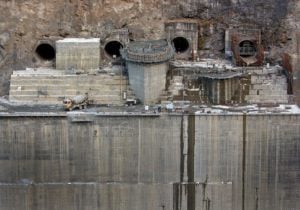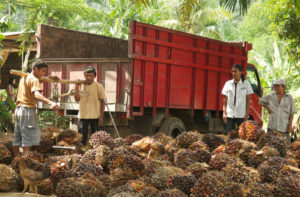In Chile, the state-owned company CODELCO, the world’s largest copper producer, last year announced the closure of Ventanas, a smelting plant in one of the most polluted areas of the country: Quintero, in the central Valparaiso region. The decision to close Ventanas followed a new episode of air pollution that affected hundreds of people and forced the closure of schools. Chile’s president, Gabriel Boric, has said he feels “shame” at the levels of environmental degradation in the area.
In response to the announcement, workers at Ventanas called a strike, claiming they hadn’t been consulted about the closure, which they said would result in the loss of local jobs. Finally, after days of tension, they agreed to end the protests, when the government committed to providing support for workers who would lose face unemployment.
What happened in Chile is being repeated all over Latin America. The transition to sustainable economies that have low greenhouse gas emissions is forcing polluting industries to change. But experts say that to avoid increasing inequalities, the way in which this takes place is just as important as its speed.
The concept of a “just transition” is being promoted by trade unions and environmental and social organisations as a key tool to ensure that the transition towards a climate-neutral economy happens in a way that’s fair to everyone. Although the concept has been around for decades, it has gained momentum in recent years, given the urgency posed by the climate crisis.
15 million
“The concept is gaining momentum,” says Javiera Lecourt, advocacy coordinator of the Just Transition in Latin America project. “Transition is not the destination, it is the journey. It is about changing work cultures and deep-rooted forms of development. It is not going to happen overnight. There are people who [work in the mining industry] and don’t know how to do anything else.”
For the International Labour Organisation (ILO), a just transition means “greening the economy in a way that is as fair and inclusive as possible for all stakeholders, creating decent work opportunities and leaving no one behind.” While this captures the general idea, the definition varies between countries and sectors, each incorporating its own point of view.
Thus, for the Trade Union Confederation of the Americas (TUCA), which brings together 48 workers’ organisations in 21 countries in the region, a just transition means changing the model of production and consumption. “There has to be a fundamental discussion in which workers have to take part,” say spokespersons of the organisation. “The just transition is about creating a new economic model.”
The origins of the just transition
Trade unions in the United States introduced the concept of just transition in the 1980s. At first, it merely referred to a programme to support workers who lost their jobs because of environmental protection policies. However, over time it came to mean something much broader: a gradual transition towards sustainable jobs and economies with a focus on leaving no-one behind.
As awareness of the climate crisis grew, trade unions began to link the just transition to action on climate change. They started campaigning for the concept to be included in international UN agreements, such as the 2015 Paris Agreement, which seeks to limit global warming.
They had some success. In its preamble, the agreement recognises “the imperatives of a just transition of the workforce and the creation of decent work and quality jobs in accordace with nationally defined development priorities.” Moreover, the concept of a just transition is linked to 14 of the 17 Sustainable Development Goals (SDGs), a set of targets adopted at the global level in 2015.
There is no single recipe. Each place needs specific approaches for its just transition
In the same year, the ILO also established a set of guidelines for a just transition, after consulting with governments, trade unions and businesses. These state that the transition should be based on a solid social consensus, respecting labour rights and adapting policies to the reality of each country and its economy.
Community and environmental organisations also established their own guidelines. For example, the Just Transition in Latin America project is calling on governments and businesses to provide opportunities for workers to retrain, to diversify their use of energy, compensate those affected negatively by the changes, and have a wide-ranging conversation at all levels of society.
“There is no single recipe for a just transition,” says Catalina Gonda, climate policy coordinator at Argentina’s Environment and Natural Resources Foundation (FARN), an NGO. “There are several lists of principles but it is a concept that has to be adjusted to local conditions. Each place needs specific approaches for its just transition.”
Moving away from fossil fuels
Of all the economic sectors in transition, energy is undergoing the greatest change. Energy accounts for almost half of Latin America’s greenhouse gas emissions. Oil, gas and coal are used in electricity generation, transport and industries, which brings an associated environmental cost.
The energy transition refers to gradually moving away from fossil fuels as a source of power and replacing them with renewable energy sources such as wind and solar. Experts describe it as a significant but necessary shift in order to avoid a further rise in global average temperature, which has already increased by at least 1.1C since the Industrial Revolution.
But the switch to renewables cannot happen in a haphazard way, community and environmental organisations and trade unions agree. That is why they call for a “just energy transition”. This means not only developing cleaner energy sources, but also a system that is fairer and more democratic and takes into account the rights of workers and communities.

“The energy sector is one of the [main contributors to] environmental conflicts and human and land rights violations,” claim Friends of the Earth, the campaign group, and TUCA in a 2022 report. To this end, they warn that the same mistakes made with fossil fuels should not be repeated as renewable energy is rolled out across Latin America.
In Mexico and Brazil, wind farms have faced opposition from rural communities where projects have been installed, who claim that they were not consulted beforehand. In Ecuador, the demand for balsa wood, one of the main materials used in the construction of wind turbine blades, has increased pressure on forests in the Amazon.
Employment in a just transition
Well-managed transitions to environmentally and socially sustainable economies can boost job creation, improve job quality and reduce inequalities, says the ILO. Latin America lost 26 million jobs during the Covid-19 pandemic. This was exacerbated by pre-existing problems such as the lack of stable employment and inequality.
Decarbonising the region’s economy could generate 15 million net jobs, according to a report by the Inter-American Development Bank (IDB) and the ILO. While 7.5 million jobs would be lost, notably in the fossil fuel sector, due to the shift to renewables, 22.5 million would be generated in solar and wind energy, forestry and construction, among other industries.
Many of the workers who would lose their jobs could transfer their skills to new industries, the report’s authors argue. But, to achieve this, companies and governments will need to implement retraining programmes and put skills development mechanisms in place to support workers during the transition.
This is especially important for Latin American cities and towns whose economies depend heavily on polluting industries such as fossil fuels, say researchers from the Stockholm Environment Institute (SEI) in Colombia. Diversifying the economy will require investment, technical support and political commitment, they add.
For example, in Argentina, thousands of people have migrated to Vaca Muerta in search of jobs in the oil industry. Economic activity in the country’s western Neuquén province revolves around the geological formation that is home to some of the world’s largest shale gas deposits.

Jonatan Nuñez, a researcher at Argentina’s National Council for Scientific and Technical Research (CONICET), argues that the relationship between jobs gained and lost in the transition raises questions. “What happens in one sector isn’t always the same in another sector,” he says. “And jobs are not necessarily created and lost in the same place.”
Nuñez believes Latin America must use the energy transition to reimagine its place in the world. The region has significant reserves of minerals that are in demand as countries move away from fossil fuels, such as lithium, which is used in electric-car batteries. But if minerals are only extracted and exported overseas, the potential to create new jobs will be very limited, he says, compared to if the minerals were instead used in local industries.
A long way to go
The concept of a just transition is gradually starting to appear in Latin American governments’ public policy documents, says José Vega Araujo, a research assistant at SEI in Colombia. “But there is still a long way to go,” he adds. “Each country must clearly define what it understands by transition and incorporate it into concrete policies.”

Among the 170 countries globally that have already updated their global climate change action plans, 65 (38%) refer to a just transition, according to United Nations analysis published last year. In Latin America, the list includes Argentina, Chile, Colombia, Costa Rica, Honduras, Dominican Republic, Paraguay, and Antigua and Barbuda.
In Chile, the Boric government created the Office of Socio-Ecological Just Transition within the Ministry of the Environment at the end of last year. The aim is to encourage people living in communities with polluting industries to engage with the private sector and the state in order to move towards a sustainable economy, the ministry said in a statement.
To this end, it is working on transition plans for so-called sacrifice zones, cities or towns whose quality of life and environment have been affected by industrial activity. The term, created by civil society organisations, refers to the impacts not only of the coal industry but also of copper, cement and chemicals, among others.

At the COP27 climate change conference in Egypt last November, Colombia announced its roadmap to a just energy transition. The country’s government, led by Gustavo Petro, will seek to replace fossil fuels with renewable energy sources based on the principles of “equity, gradualism and community participation”, according to a document presented at the summit.
As the country’s second-largest export, coal is the Colombian economy’s most important mineral, sustaining more than 130,000 jobs. The government has assured the sector that these are not at risk, as the transition will be gradual and the tourism and agriculture sectors will be able to absorb those left unemployed by the coal industry. According to Petro, Colombia has a decade of fossil fuel exports left.
Trade unions and social and environmental movements in Latin America acknowledge that the transition is already happening in most countries of the region. However, they believe there’s still time to shape how it takes place, asking governments and industries to start a dialogue to find common ground for the best way forward in as exclusive a way as possible.
“Cleaning up polluting industries for the sake of an energy transition doesn’t have to mean creating new inequalities or deepening already existing ones,” Gonda says. “Everyone needs a seat at the table to discuss what a just transition means to them, considering the specific needs for each sector – from communities to industries to governments.”









